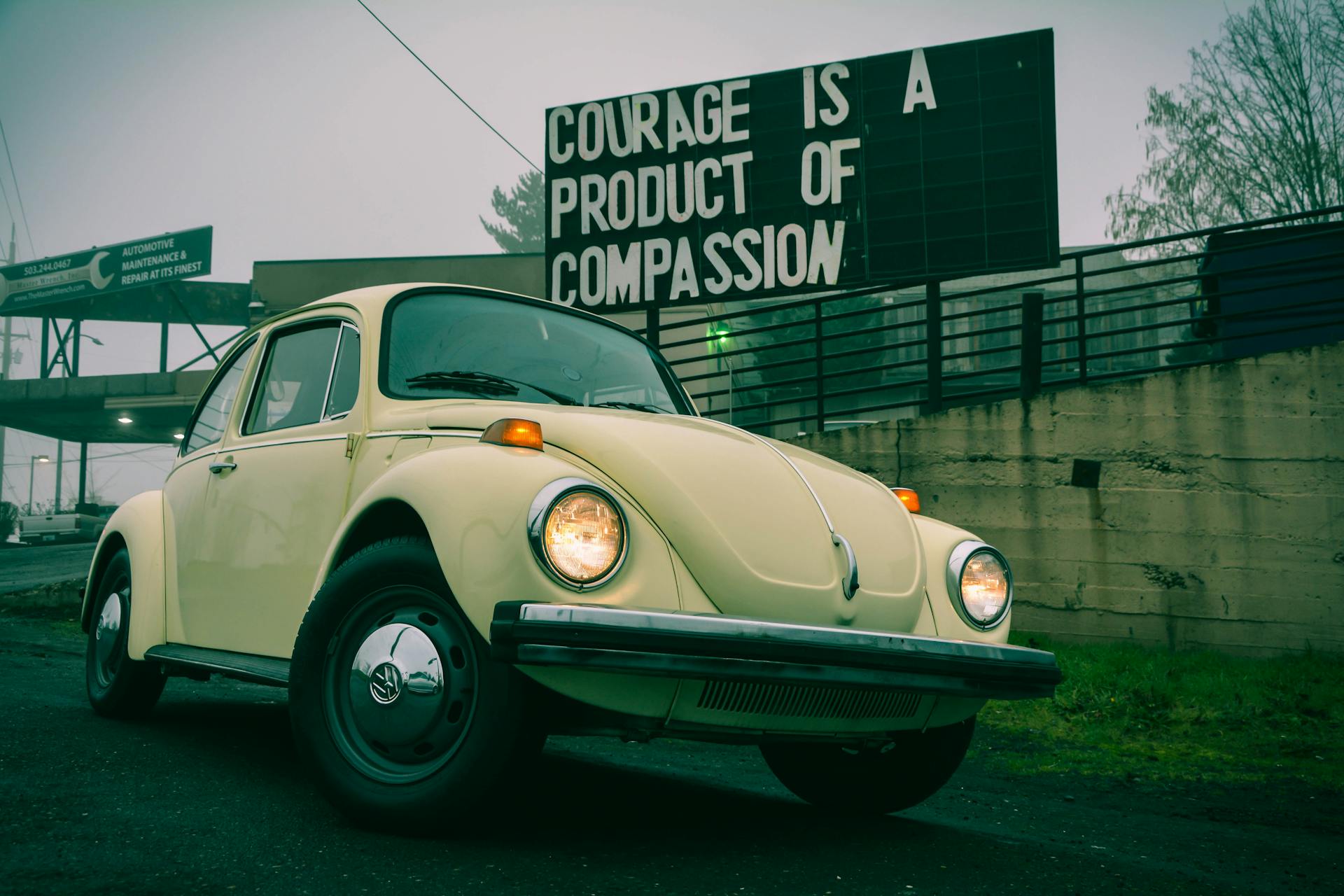
If you're a driver with a less-than-perfect record, you're likely to face higher premiums or even be declined by standard auto insurance companies.
Many non-standard auto insurance companies specialize in covering high-risk drivers, who are often defined as those with multiple tickets, accidents, or DUIs.
Some non-standard auto insurance companies offer coverage for drivers with poor credit scores, which can be a major factor in determining insurance rates.
These companies often provide flexible payment options, including monthly payments, to help make insurance more affordable for drivers who may be struggling financially.
Additional reading: How Do Insurance Companies Reduce the Risk of Moral Hazard
What Is It and Why Do I Need It?
Non-standard auto insurance is a category of car insurance for drivers labeled high-risk due to past driving offenses, lapses in auto insurance coverage, or other major risk factors. These drivers are considered higher risk by insurance companies, which means they often pay more for their insurance premiums.
A high-risk driver is someone with multiple accidents, moving violations, insurance claims, or any combination of the above. If you have multiple tickets or accidents on your driving record, you'll likely be labeled high-risk.
For another approach, see: High Risk Motorcycle Insurance
Non-standard insurance is also required for drivers who have had a lapse in insurance coverage. In nearly every state, drivers are required to have a car insurance policy, so insurance companies like to see a consistent record of coverage. Drivers who weren't insured at some point, even for less than 30 days, are considered riskier.
Some drivers may need non-standard auto insurance due to a salvage title on their vehicle. A salvage title denotes that your vehicle has been damaged and/or deemed a total loss by an insurance company, making it very difficult to insure again.
Here are some reasons you may need non-standard auto insurance:
- Multiple accidents or moving violations on your driving record
- Lapse in insurance coverage
- Salvage title on your vehicle
- SR-22 requirement due to a DUI or reckless driving conviction
- Non-owner car insurance (for drivers who don't own a car but frequently drive)
Types of Non-Standard Auto Insurance
Non-standard auto insurance can be confusing, but it's actually quite straightforward once you understand the different types. For example, "Usage-Based Insurance" is a type of non-standard auto insurance that tracks your driving habits and offers discounts based on your behavior.
This type of insurance is perfect for safe drivers who want to save money on their premiums. By installing a small device in your car, you can earn discounts for things like low speeds, smooth braking, and minimal hard acceleration.
A fresh viewpoint: Non-Standard Finance Plc
"Pay-As-You-Drive" insurance is another type that charges drivers based on their actual mileage. This can be a great option for people who drive infrequently or have a short commute.
With "Pay-Per-Mile" insurance, drivers are charged a base rate plus a per-mile fee. This can be more expensive than traditional insurance, but it may be worth it for those who drive very few miles.
"Usage-Based" and "Pay-Per-Mile" insurance can be beneficial for drivers who want to save money and drive safely. By earning discounts and being charged only for the miles they drive, these types of insurance can be a win-win for both drivers and insurers.
Readers also liked: Auto Insurance for Uninsured Drivers in Georgia
How to Get Non-Standard Auto Insurance
You can purchase non-standard or high-risk auto insurance the same way you would any other policy. Many insurance companies offer non-standard auto insurance as a separate tier of coverage.
Some large companies control smaller companies that may have better rates for non-standard insurance than the parent company. These smaller companies can offer more competitive rates for drivers who are considered high-risk.
To get non-standard auto insurance, you'll need to pay a filing fee when your state requires an SR-22. This form proves to your state that you have adequate auto insurance.
Explore further: Reliance Standard Insurance Co
How Do I Get?
You can purchase non-standard or high-risk auto insurance the same way you would any other policy. This means you'll need to shop around and compare rates from different insurance companies.
Some large companies control smaller companies that may have better rates for non-standard insurance than the parent company. This is something to keep in mind when shopping for insurance.
If your state requires an SR-22 from you, your insurance company will need to file the form to prove to your state that you have adequate auto insurance. This typically involves paying a filing fee.
Your premiums will increase by a lot if you need to file an SR-22. This is an additional cost on top of your regular insurance premiums.
Here are some examples of insurance companies that offer non-standard auto insurance:
- Best California Auto Insurance
- Cheap Florida Car Insurance
- Best Car Insurance in Texas
- Cheap New York Car Insurance
- Best Georgia Auto Insurance
- Cheap Michigan Car Insurance
How to Choose
Choosing the right non-standard auto insurance policy can be overwhelming, but it's essential to assess your needs and consider key factors. Understanding your driving history is crucial to determine what coverage you need.
Look at your driving history and requirements to determine what coverage you need. This will help you make an informed decision about your policy.
Consider customer service, coverage options, and the reputation of the insurer to make an informed decision. You can also explore other insurance options available, such as General Liability, or coverage for specific vehicles like motorcycles, ATVs, boats, or RVs.
Cost and Coverage
The cost of non-standard auto insurance varies depending on your state and the reason for non-standard insurance.
In most states, age has the largest influence on rates, with teenage drivers paying more than drivers guilty of a DUI-related accident.
Non-standard auto insurance can include a variety of coverage options, such as liability coverage, collision coverage, and comprehensive coverage.
Here are some of the coverage options available:
- Liability coverage: Helps to protect against claims from others for injuries or damages.
- Collision coverage: Helps to pay damage to your vehicle due to covered collision accidents.
- Comprehensive coverage: Helps to pay for damage to your vehicle involving covered non-collision-related incidents like theft, fire or vandalism.
Cost
The cost of non-standard auto insurance can be a significant concern for many drivers.
Non-standard auto insurance premiums can be higher than standard auto insurance because you're deemed to be a certain risk level.
Take a look at this: Non Standard Home Insurance Companies
Age has a surprisingly large influence on rates in most states, with teenage drivers paying more than drivers guilty of a DUI-related accident.
Being labeled non-standard means your policy premium could be higher than your standard auto insurance counterparts.
Avoiding accidents and traffic violations is crucial to keeping a clean driving record, which can help lower your premiums over time.
Shopping around and comparing insurance quotes can help you receive the best rate available, so don't be afraid to shop around.
Establishing a clean driving record may qualify you for lower rates, or 'standard insurance policies' as they may be called.
Intriguing read: Non Standard Auto Insurance Florida
Deductibles
Deductibles can be a significant out-of-pocket expense for many people.
An insurance policy deductible is the amount of money you're responsible for paying before your insurance company will pay a claim.
This amount can vary greatly depending on the policy and provider, but it's usually a fixed amount stated in the policy.
Paying a deductible is a normal part of using insurance, and it's essential to understand how it works to avoid unexpected expenses.
Intriguing read: Assurant Deductible T Mobile
Coverage Options

When you're shopping for insurance, understanding your coverage options is crucial. Non-standard auto insurance offers various coverage options to protect you and your vehicle.
Liability coverage is a must-have, as it helps protect against claims from others for injuries or damages.
Collision coverage is another essential option, paying for damage to your vehicle due to covered collision accidents.
Comprehensive coverage is also available, helping to pay for damage to your vehicle involving covered non-collision-related incidents like theft, fire, or vandalism.
You can also consider other insurance options, such as General Liability, which provides protection against claims for injuries or damages.
If you own a motorcycle, ATV, boat, or RV, you can also get coverage for those vehicles.
Here are some key coverage options to consider:
- Liability coverage
- Collision coverage
- Comprehensive coverage
- General Liability
- Motorcycle, ATV, Boat, RV Coverage
Differences from Standard Insurance
The primary difference between non-standard and standard auto insurance is the risk assessment. Non-standard policies are tailored for drivers with unique circumstances that make them more likely to file a claim.
Non-standard policies often come with higher monthly premiums compared to standard policies. This is because non-standard insurers are taking on more risk by covering drivers who may be considered higher risk.
A lapse in insurance coverage won't automatically put you in the nonstandard auto insurance category, but too many lapses of time with no auto insurance can make you appear risky to a potential insurer.
Expand your knowledge: List of Insurances
Inconsistent
Inconsistent auto insurance coverage can be a major red flag for potential insurers. A lapse in insurance coverage, even if it's just for a short period, can make you appear risky to a potential insurer.
If you've had a lapse in insurance coverage, you might be surprised to know that it won't automatically put you in the nonstandard auto insurance category. However, multiple lapses of time with no auto insurance can make you appear high-risk.
Here are some examples of how different states handle lapses in insurance coverage:
These numbers show that even a speeding violation can increase your insurance rates significantly, especially in states like New Jersey and New York.
Worth a look: Lemonade Renters Insurance New York
Differences from Standard
Non-standard auto insurance is tailored for drivers with unique circumstances that make them more likely to file a claim. This often results in higher monthly premiums compared to standard policies.
Non-standard policies are designed for drivers who don't fit the typical mold, and as a result, they may have to pay more for their coverage. The good news is that the coverage provided is generally the same as standard policies.
The primary difference between non-standard and standard auto insurance is the risk assessment, which means that non-standard policies are created with the specific needs of these drivers in mind.
A different take: Can You Have Two Pet Insurance Policies
What Is an Insurer?
An insurer is essentially a company that provides insurance policies to individuals. Some insurers specialize in selling one type of insurance classification.
An example of a specialized insurer is a nonstandard insurer, which sells nonstandard auto insurance policies.
Intriguing read: Vehicle Insurance Policies
What Is an SR-22?
An SR-22 is a certificate that proves you have the minimum required auto insurance for the state you live in.
It's often mandated for drivers with serious traffic offenses, such as those who have been involved in accidents while uninsured.
An SR-22 is a way to show that you're financially responsible and have the necessary coverage to operate a vehicle in your state.
If you're required to get an SR-22, it's usually because of a serious traffic offense, like being involved in an accident without insurance.
Status Loss
Losing your high-risk status is possible, and it's a great goal to work towards. You don't have to be classified as high-risk forever.
Driving penalties can stay on your record for a certain amount of time, depending on the penalty. This means that if you've made mistakes in the past, you can still improve your driving record over time.
Taking positive steps can help you fall out of the high-risk category. This includes driving defensively to prevent accidents, following all traffic and parking laws, and driving a car with advanced safety features.
A unique perspective: High Risk Commercial Auto Insurance
To maintain the right non-standard auto insurance coverage, working with a reputable insurance company like Just Auto Insurance can be beneficial. They can help you find the right policy to suit your needs.
Here's a summary of the steps you can take to lose your high-risk status:
- Drive defensively to help prevent accidents
- Be mindful about following all traffic and parking laws
- Drive a car with advanced safety features
- Work with Just Auto Insurance to maintain the right non-standard auto insurance coverage
Frequently Asked Questions
What defines non standard insurance?
Nonstandard insurance is for drivers with a higher risk profile, often due to inexperience, lapses in coverage, or a history of traffic violations. This type of insurance is designed for those who may not qualify for standard auto insurance rates.
Who are your top 3 non-standard carriers?
Our top 3 non-standard carriers are GEICO, Progressive, and Kemper, with the highest review scores among non-standard insurance providers. Check out average rates and more information on these top picks.
Is Progressive a non-standard company?
Yes, Progressive was founded as a specialty underwriter of nonstandard insurance, which means they initially focused on insuring drivers who didn't fit traditional insurance company profiles. This nonstandard roots have shaped their approach to insurance and customer service.
What is a substandard insurance company?
A substandard insurance company offers policies with higher premiums and special provisions for individuals who pose a higher risk, such as those with pre-existing medical conditions or poor credit history. These policies are often more expensive and have stricter terms than standard insurance policies.
Sources
- https://www.valuepenguin.com/auto-insurance/nonstandard-auto-insurance
- https://www.dairylandinsurance.com/resources/nonstandard-auto-insurance-guide
- https://www.infinityauto.com/knowledge-center/understanding-insurance/non-standard-auto-insurance
- https://www.insuranceshopllc.com/personal/coverage/non-standard-auto.php
- https://justautoins.com/non-standard-auto-insurance/
Featured Images: pexels.com


